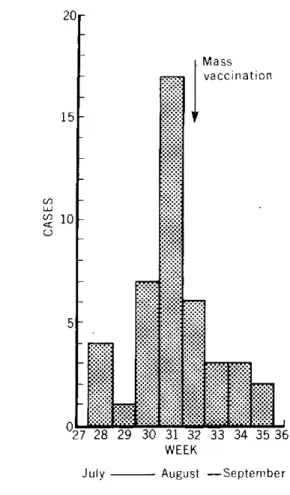Table 1. Distribution of meningococcal meningitis cases by age-group, Osorno, Chile, 1979.
Age (in years) No. of cases %
0-1 2-5 6-10 11-15 20 and over Not recorded
Total
1 28.2
5 12.8
8 20.5
4 10.3
9 23.1
2 5.1
39 100.0
Table 2. Mass meningococcal vaccination, August 1979.
Area <5 years 6-18 years Total
Osorno, Chile,
en c3
U.) Program
%
Urban 10,856 44.964 55.820 98
Rural 6.903 21,297 28.200 92
Total 17.759 66,261 84,020 96
spinal fluid; in 2, it was based on clinical symptoms. Of the strains isolated, 57 per cent proved resistant to the sulfonamide.
The case fatality rate was 15.4, and almost all the deaths (5 out of 6) occurred in children under 2 years of age.
Mass vaccination was carried out for a period of three days (14, 15, and 16 August) among the total popula-tion aged 2-18 years of the Province; polyvalent menin-gococcal vaccine A and C prepared by the Merieux Institute was used.
Furthermore, all direct contacts of the cases were treated for 4 days with rifampin, adults receiving 600 mg daily, 5-12 year-old children 300 mg daily, and those younger than 5 years of age 20 mg daily per kg
of body weight.
5
Weekly incidence of meningococcal meningitis, Osorno, Chile, 1979.
2 0r
15
101
-rl-vaccination
1 h
1
. .
UI -- -
--27 28 29 30 31 32 WEEK
33 34 35 36
July August -September
Epidemiological surveillance subsequent to the vac-cination campaign made it possible to confirm 8 ad-ditional cases in the following weeks, but no further cases were detected thereafter.
(Source: Government of Chile, Ministry of
Public Health, Vigilancia de enfermedades
transmisibles y zoonosis 6 (10), October, 1979.)
Vitamin D Intoxication in Venezuela
( In June 1979, two rural families in Carabobo State shared a 5-liter drum of oil containing 2 million IU of
vitamin D3per gram.
In the course of 6 weeks, 16 persons consumed food prepared with this oil. At the end of approximately 1
month, the first symptoms appeared: vomiting, ano-rexia, progressive loss of weight (an average of 16 kg), irritation of eyes, dizziness, and, in some cases, a sharp pain in the lower extremitiesOf the 4 children in-volved, 2 were unable to walk, one had difficulty in
10
.
... -; {+} @ .- }a f
I
¡?il '-'- -y",Y
-V
- 'D
moving the upper right arm, and another had facial paralysis.
The examinations made showed hypercalcemia in all of them, and X-ray photographs showed raising of the periosteum in the patella of a 7 year-old child.
The 16 cases were hospitalized in Valencia, and treat-ment consisted in isolation from sunlight, a milkless diet, corticoids, and diuretics.
On 29 August a 6-year-old girl died. The autopsy showed marked acute bilateral pulmonary edema with bilateral bronchopneumonic foci, increased compact-ness of the lungs, moderately enlarged liver with mild jaundice, moderately enlarged spleen, hard pancreas
with calcified foci, large and hard kidneys, and right fibula with thickening of the periosteum. Microscopic examination confirmed the calcification of kidney tissues and of the spleen.
This was the only fatal case, but there were 9 cases with liver/kidney insufficiency and generalized cal-cinosis.
(Source: Government of Venezuela, Ministry
of Health and Social Welfare, Boletín
Epidemiológico Semranal. Nos. 30 and 47, 1979.)
Brucellosis Outbreak in Alberta, Canada
rIn 1977, eight cases of brucellosis were reported among workers in a meat packing plant in Alberta Province, Canada. Between May and November 1978, six cases of the disease, in which an occupational risk was indicated, were notified to the Alberta Workers' Health, Safety, and Com ensation, the social security institution of the provinc This led to an epidemiologi-cal investigation in which loepidemiologi-cal, provincial, and federal agencies actively collaborated, as did the management and workers of the meat-packing plant.
To determine the presence of Brucella antibodies, 193 workers were examined; 17 of them (8.8 per cent)
were found to be seropositive. Of the latter 17, 14 had been employed at the plant for 5 years or less. The risk of infection was six times greater for workers who did not wear glasses than for those who did. It was esti-mated that the daily slaughter of 20-25 head of cattle that were reactors to brucellosis was the critical limit, above which the risk of human infection increased. This fact was associated with the outbreak of brucellosis
in the plant.
(Source: Canada Diseases Weekl' Report.
2 February 1980.)
Current Progress in Tubei
JBacteriologic Bases of Short-course Chemotherapy
The purpose of tuberculosis chemotherapy is to steri-lize lesions quickly and completely, and the drugs are
*Extract of the conclusions of the 1II Regional Seminar on
Tubercu-losis Cheniotherapy, PAHO, Washington. D.C.. 27-30 March 1979.
rculosis Chemotherapy*
used to avoid the failures caused by bacterial resistance and to avert relapses.
Despite the high proportion of mutants resistant to drugs among wild strains of tubercle bacilli, selection of resistant bacilli is easily avoided by appropriate com-binations of active drugs, that is, drugs to which the bacilli are sensitive)
11
